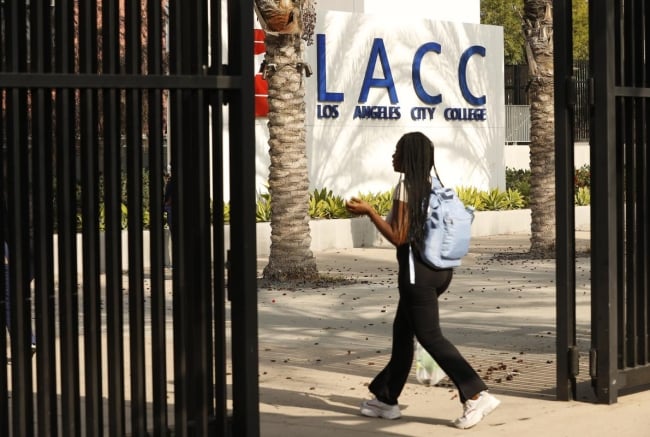You have /5 articles left.
Sign up for a free account or log in.

Al Seib /Contributor/Los Angeles Times/Getty Images
A new report from the Campaign for College Opportunity, a California-based research and policy advocacy organization, highlights ongoing equity gaps for Black and Latinx students pursuing higher education in Los Angeles County.
The report, released today, describes some notable gains in Black and Latinx students’ access to college and their academic outcomes. However, it also notes stubborn education disparities and suggests the COVID-19 pandemic could “threaten to offset and undo years of improvements for California’s high schools and community colleges” in particular.
Michele Siqueiros, president of the Campaign for College Opportunity, said Los Angeles County is “the most populous, most significant county” in California, so the report has broader implications for the state. The county is home to about a third of the Black and Latinx residents in the state, and California has the most Latinx residents of any state and the fifth-largest Black population in the country.
“If we’re not being intentional about how we’re preparing Latino and Black Angelenos, it is a bellwether to the state of California,” she said. “Unless we do better at providing both college preparation and opportunity to Los Angeles residents, especially Latino and Black residents, it’s not going to bode well for the state or for the country.”
The report draws on data from the California Department of Education, the state’s public higher education systems and CalPass Plus, a statewide source of longitudinal data on education.
A hopeful data point noted in the report was a significant increase in the share of Black and Latinx high school graduates from the Los Angeles Unified School District who were eligible to get into a four-year university in the state. The percentage of Black and Latinx high school graduates who met the California State University and University of California systems’ requirement to earn a C grade or higher in a core set of classes, called A-G courses, nearly doubled over about a decade. The school district made completing the set of courses a graduation requirement starting with the high school graduating Class of 2016, a policy that has paid dividends, according to the report.
However, the report says the pandemic posed a setback to that progress. In 2020, as the pandemic raged, the percentage of Black high school graduates from district schools who earned a C or above in A-G courses fell to 46 percent from 53 percent, and the percentage of Latinx graduates who got the necessary grades in these courses dropped to 54 percent from 63 percent. In comparison, 67 percent of white students from the district completed the classes that year.
Chris Nellum, executive director of Education Trust–West, said completing these courses at lower rates limits Black and Latinx students’ college options.
“Our high schools in Los Angeles and elsewhere have a responsibility to make sure every young person completes that series of courses, so that they are eligible, so that they have a choice,” he said. “I think if we artificially limit folks’ choice sets, that’s a really big concern. Community college is a fine option if a young person made a choice, a true set of choices.”
Siqueiros said A-G course completion rates for Black and Latinx students rebounded in 2021. Nonetheless, the “plummeting of A-G eligibility” for these students during the height of the pandemic was “disturbing,” and gaps for Black and Latinx high school students relative to white peers haven’t closed.
“There continue to be real inequities in college access and preparation for students based on race,” she said.
Siqueiros also believes the pandemic contributed to steep enrollment declines in the Los Angeles Community College District, especially among Black and Latinx first-time college students. LACCD enrollments dropped more than 30 percent from fall 2019 to fall 2020, higher than the national average for community colleges during that time period. Black first-time student enrollment in the district fell 40 percent, and Latinx first-time student enrollment dropped 32 percent from fall 2019 to fall 2020.
“L.A. County in particular was hugely impacted by the pandemic in terms of folks that contracted COVID-19, were affected by COVID-19, lost a loved one to COVID-19,” Siqueiros said. “L.A. County was one of the most severely hit regions … not only health-wise but in terms of jobs and opportunities.”
The report also found that only 6 percent of Black students and 7 percent of Latinx students graduated with a certificate or degree within three years at LACCD colleges. These students also had lower transfer rates than their white peers. Thirteen percent of Latinx and Black students who enrolled in the district in the 2014–15 academic year transferred to a four-year institution within four years, compared to 23 percent of white students. Meanwhile, only a third of Black students who graduated with associate degrees from LACCD colleges earned an associate degree for transfer, which guarantees admission to a college in the CSU system. Latinx associate-degree earners in the district fared better, with more than half graduating with an associate degree for transfer.
Nellum said high levels of financial need among these students contribute to low graduation rates. He also pointed out that colleges need to ensure they’re not placing Black and Latinx students into “traditional, ineffective remedial education courses,” which can delay their transfers and graduations.
The report notes that LACCD campuses continue to offer a significant number of remedial courses, despite legislation in California that aimed to curtail remedial education at community colleges.
The report offered some hopeful findings about graduation rates at Cal State L.A. and the University of California, Los Angeles. Half of all Black and Latinx first-time, full-time students who enrolled at Cal State L.A. in fall 2015 graduated within six years, though four-year and six-year graduation rates lagged for Black and Latinx students across CSU campuses in the county relative to white students. Latinx transfer students to Cal State L.A. graduate within two and four years at rates higher than their white peers. At UCLA, 80 percent of Black and Latinx first-time students graduate within six years. The report says the university “substantially reduced” equity gaps in four-year graduation rates among first-time students who enrolled in fall 2016 relative to students who enrolled five years earlier.
However, the report also notes that less than a quarter of UCLA students are Latinx, even though 74 percent of K-12 student in the city of Los Angeles are Latinx and it’s the largest ethnic group in the state. Only 5 percent of the UCLA student body was Black in fall 2020. The number of Black and Latinx students admitted from California high schools has fallen since 2016. UCLA is the only University of California campus in Los Angeles County.
“That’s a huge problem,” said Tyrone Howard, a professor of education at UCLA. “UCLA should look something like Los Angeles, and right now it doesn’t.”
He believes Black and Latinx students are underrepresented at the university in part because students from the county’s predominantly Black and Latinx high schools are less likely to have robust guidance on the admissions process. He said the university should do more outreach to middle and high schools that serve these students so that students know to enroll in Advanced Placement courses and take other steps that will boost their applications.
Howard also wants to see the university do more targeted outreach to Black and Latinx students once they’re on campus to ensure they’re aware of campus resources and invest in efforts, such as providing students with affinity cultural centers and other spaces to gather, to foster a sense of community. He noted that UCLA opened a Black Resource Center this year after more than five years of student advocacy.
“I think there’s got to be more done to ensure that there are adequate supports in place for Black and Latinx students, academically, socially, emotionally, culturally that helps to create a sense of belonging for those students and a sense of support, financially and otherwise,” he said.
Nellum said people sometimes perceive Los Angeles and its equity challenges as “too big and too hard to figure out.” He hopes readers of the report realize “because it is so big, we need to be particularly focused on making sure L.A. gets it right, it does well by the enormous amount of Black and brown students and all of their students.”









